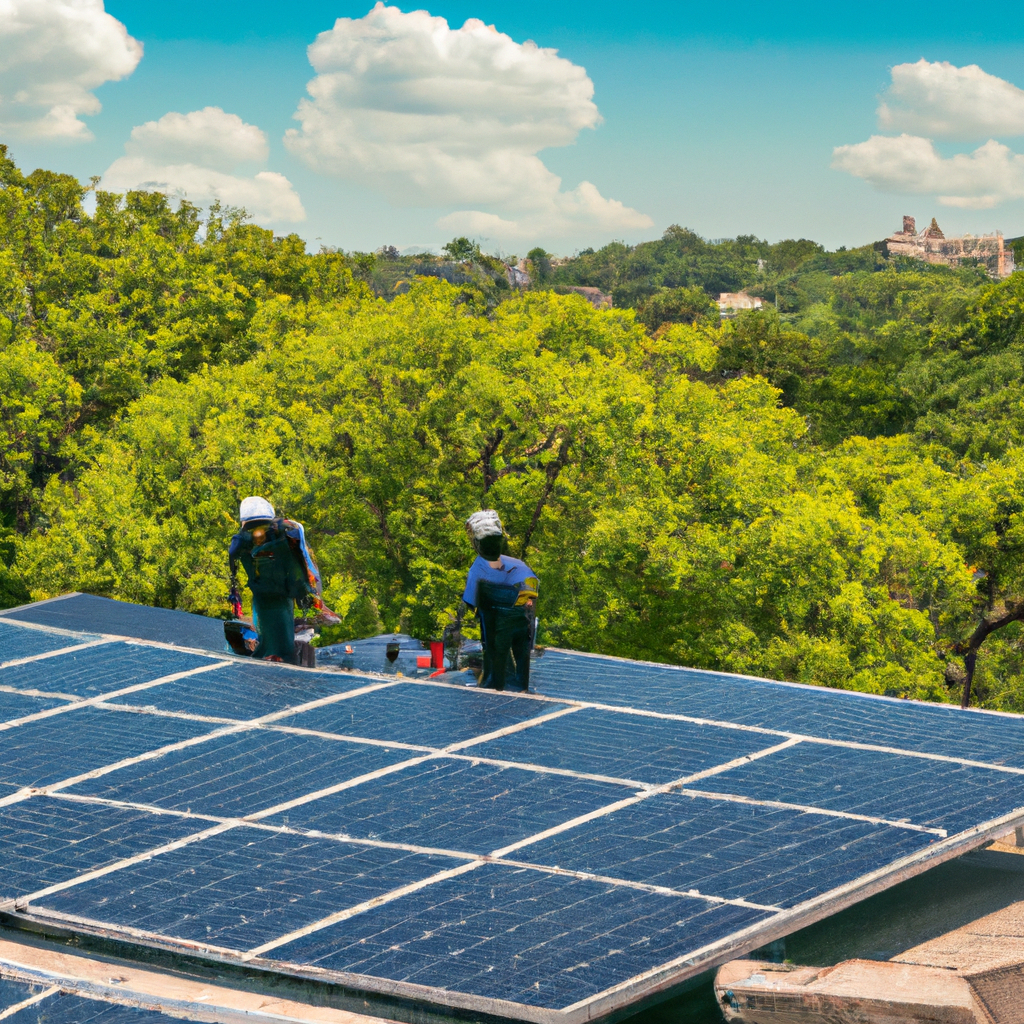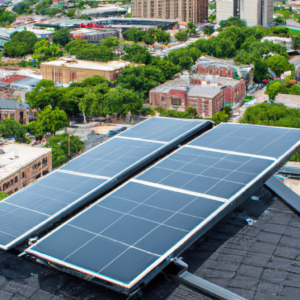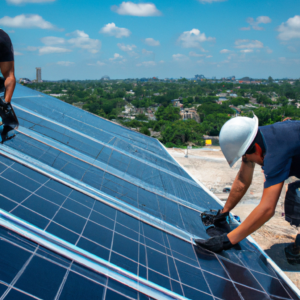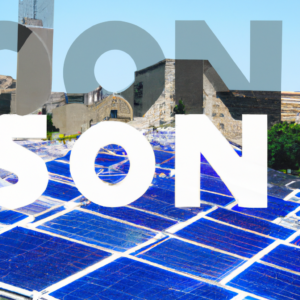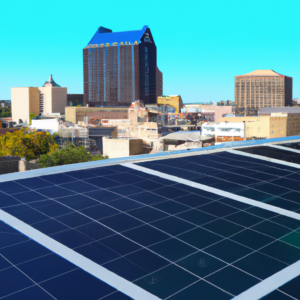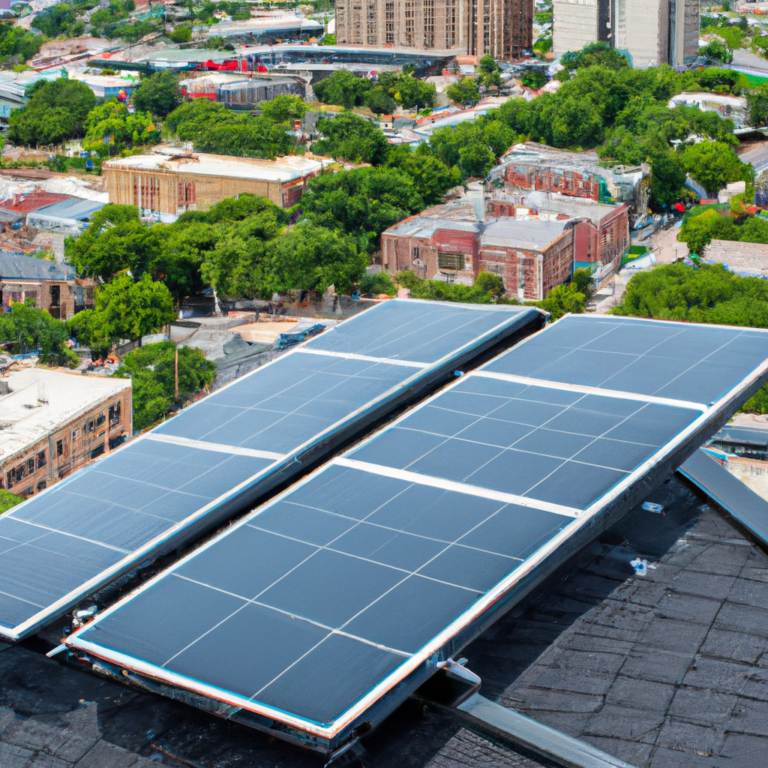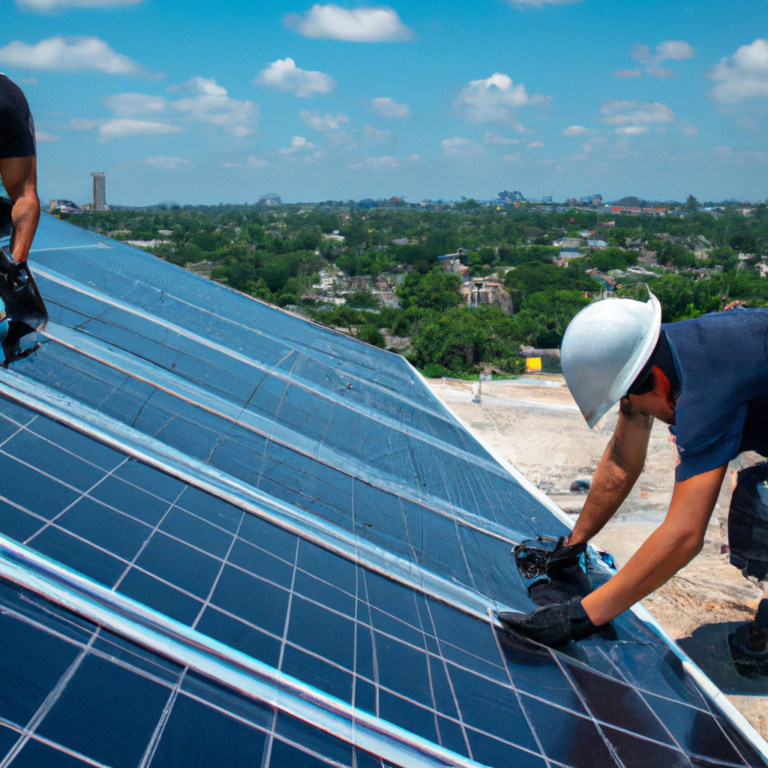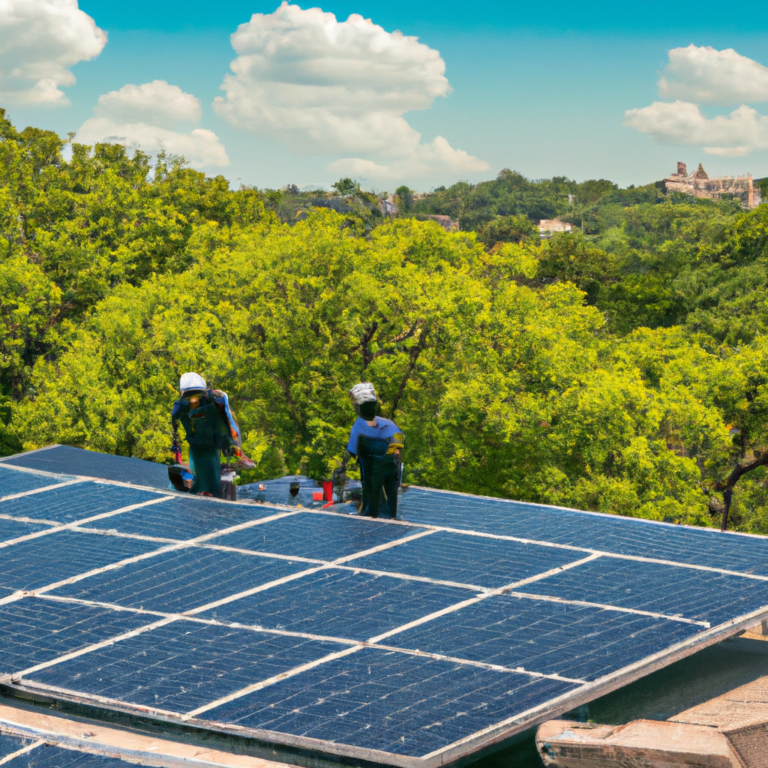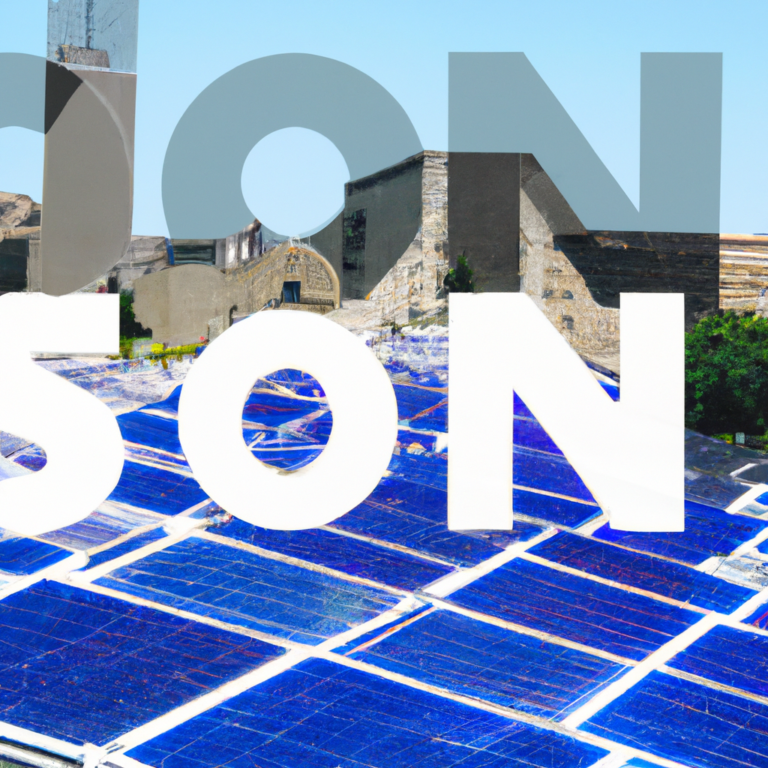Ready to brighten up San Antonio with solar power? Look no further than this ultimate guide to solar panel installation.
Discover the numerous benefits of solar energy, assess your home’s solar potential, and choose the right panel system for your needs.
Find a qualified installer and understand the installation process step-by-step.
Plus, learn how to maximize the return on your solar investment.
Get ready to harness the power of the sun and make a positive impact on your energy consumption.
Benefits of Solar Energy
When you install solar panels in your home, you can enjoy numerous benefits of solar energy. One of the most significant advantages is the financial savings it offers. By generating your own electricity, you can reduce or even eliminate your monthly utility bills. Solar panels have a long lifespan of around 25 to 30 years, providing you with decades of energy savings. Additionally, many governments and utility companies offer incentives and tax credits for solar panel installations, further enhancing your financial benefits.
Apart from the financial savings, solar energy also has a positive environmental impact. Solar power is a clean and renewable source of energy that produces no greenhouse gas emissions or air pollutants. By using solar energy, you can reduce your carbon footprint and contribute to a healthier environment. With the increasing concerns about climate change and the importance of sustainable living, adopting solar energy is a responsible choice that benefits both your pocket and the planet.
Assessing Your Home’s Solar Potential
To determine the solar potential of your home, evaluate its sun exposure throughout the day and year. Here are four key factors to consider when assessing your home’s solar potential:
-
Orientation: The orientation of your home in relation to the sun is crucial for maximizing solar energy. South-facing roofs receive the most sunlight throughout the day.
-
Shade: Assess any potential shade sources that might obstruct sunlight from reaching your solar panels. Nearby trees, buildings, or tall structures can cast shadows that reduce solar energy production.
-
Roof condition: Evaluate the condition and structural integrity of your roof. Solar panels require a sturdy and well-maintained roof to support their weight.
-
Roof slope: The slope of your roof affects the amount of sunlight your solar panels will receive. Optimal slopes usually range between 30 to 45 degrees.
Choosing the Right Solar Panel System
Assess your home’s solar potential to determine the best solar panel system for your needs. When choosing the right solar panel system, it’s important to consider solar panel efficiency and government incentives.
Solar panel efficiency refers to the amount of sunlight that a solar panel can convert into electricity. Higher efficiency panels can generate more electricity with the same amount of sunlight. This is especially important if you have limited roof space or if you want to maximize your energy production.
Additionally, government incentives such as tax credits and rebates can significantly reduce the cost of installing a solar panel system. Make sure to research and take advantage of these incentives to make your solar panel installation more affordable.
Finding a Qualified Solar Installer
When it comes to finding a qualified solar installer, there are three key points to consider.
First, check their credentials and certifications to ensure they’ve the necessary qualifications for the job.
Second, look for experience and expertise in solar panel installation to ensure they’ve a proven track record.
Finally, read customer reviews and testimonials to get an idea of their reputation and customer satisfaction.
Credentials and Certifications
Finding a qualified solar installer can be made easier by looking for those with relevant credentials and certifications. When searching for a solar installer, it’s important to ensure that they meet accreditation requirements and adhere to industry standards.
Here are some key credentials and certifications to consider:
-
NABCEP Certification: The North American Board of Certified Energy Practitioners (NABCEP) offers various certifications, including PV Installation Professional and PV Technical Sales. This certification ensures that the installer has met rigorous standards in solar photovoltaic system installation and design.
-
State Licenses: Check if the installer holds valid licenses specific to solar installation in your state. Different states may have different licensing requirements, so it’s crucial to verify their compliance with local regulations.
-
Manufacturer Certifications: Some solar panel manufacturers provide certifications to installers who’ve received training in their specific products. This certification ensures that the installer has the necessary knowledge and skills to handle the specific brand of solar panels.
-
Membership in Industry Associations: Look for installers who are members of reputable industry associations such as the Solar Energy Industries Association (SEIA) or the American Solar Energy Society (ASES). Membership in these organizations indicates that the installer is committed to upholding industry best practices and staying up-to-date with the latest advancements in solar technology.
Experience and Expertise
To ensure a successful solar panel installation, you need a qualified installer with ample experience and expertise in the field. Evaluating a solar installer’s experience is crucial in determining their ability to handle your project efficiently. Look for installers who’ve been in the industry for several years and have a proven track record of successful installations. Experience brings knowledge and expertise, allowing installers to navigate potential challenges and deliver high-quality work.
When evaluating a solar installer’s experience, consider their portfolio of completed projects. Look for installations similar to yours in terms of size and complexity. This will give you an idea of their ability to handle your specific requirements. Additionally, check for any certifications or accreditations they may have obtained, as these demonstrate their commitment to industry standards and best practices.
Industry standards play a crucial role in ensuring the safety and efficiency of solar panel installations. A qualified solar installer will be well-versed in these standards and will follow them diligently throughout the installation process. By adhering to industry standards, they can guarantee the quality of their work and provide you with a system that meets all safety and performance requirements.
Customer Reviews and Testimonials
Check out the customer reviews and testimonials to find a reliable and qualified solar installer for your project. Reading what other customers have to say about their experience with a solar installation company can give you valuable insights into their level of customer satisfaction and the quality of their installation process.
Here are some key things to look for in customer reviews and testimonials:
-
Positive feedback about the installation process: Look for comments that mention the efficiency, professionalism, and expertise of the solar installer during the installation process.
-
High customer satisfaction ratings: Look for reviews that express overall satisfaction with the solar installation company, including their communication, customer service, and the performance of the installed solar panels.
-
Specific details about the installation: Pay attention to reviews that provide specific information about the installation, such as the timeline, any challenges encountered, and how the installer addressed them.
-
Recommendations and referrals: Look for reviews that mention the customer’s willingness to recommend the solar installer to others, as this is a good indication of their confidence in the company’s services.
Understanding the Solar Panel Installation Process
Now that you have found a qualified solar installer, it’s important to understand the solar panel installation process.
This involves obtaining necessary permits and paperwork, choosing the right panels for your needs, and understanding the installation timeline and cost.
Necessary Permits and Paperwork
Before beginning the solar panel installation process in San Antonio, you must familiarize yourself with the necessary permits and paperwork. Obtaining the proper permits is crucial to ensure compliance with local regulations and to avoid any potential legal issues.
Here are the key steps you need to take:
-
Permit Application: Start by submitting a permit application to the appropriate local authorities. This typically involves providing detailed information about your solar panel system, such as its size, location, and design.
-
Code Compliance: Make sure your installation adheres to all applicable building codes and regulations. This includes factors like structural integrity, electrical wiring, and fire safety.
-
Utility Interconnection Agreement: Contact your utility company to establish an agreement for connecting your solar panel system to the grid. This step ensures proper integration and allows you to take advantage of any available incentives or net metering programs.
-
Documentation: Keep all relevant documents, including permits, agreements, and warranties, organized and easily accessible. These records will be important for future reference and potential maintenance or insurance purposes.
Choosing the Right Panels
To ensure a successful solar panel installation in San Antonio, it is essential to choose the right panels that will meet your energy needs while adhering to local regulations and building codes. When selecting solar panels, there are several factors to consider, including panel efficiency and government incentives. Panel efficiency refers to the amount of sunlight that a panel can convert into electricity. Higher efficiency panels produce more electricity in the same amount of space, making them ideal for homes with limited roof space. Additionally, government incentives, such as tax credits and rebates, can significantly reduce the cost of installing solar panels. It is important to research and understand the available incentives in your area to maximize your savings.
| Panel Brand | Panel Efficiency |
|---|---|
| Brand A | 20% |
| Brand B | 18% |
| Brand C | 22% |
| Brand D | 19% |
In the table above, you can see the panel efficiencies of different brands. It is advisable to choose a brand with higher efficiency to maximize the electricity generation from your solar panels.
Installation Timeline and Cost
When choosing the right panels for your solar panel installation in San Antonio, it’s important to understand the installation timeline and cost, allowing you to plan and budget accordingly. Here is a breakdown of the installation timeline and a cost analysis to help you make informed decisions:
-
Consultation and site assessment: A solar panel installation begins with a consultation and site assessment to determine the feasibility of the project and to gather information about your energy needs.
-
Design and permit process: After the initial assessment, the next step is designing the solar system and obtaining necessary permits from local authorities.
-
Equipment procurement and installation: Once the design and permits are in place, the solar panels and other necessary equipment are procured and installed on your property.
-
Grid connection and final inspection: After installation, the solar panels are connected to the grid, and a final inspection is conducted to ensure everything meets safety and quality standards.
As for the cost analysis, it varies depending on factors such as the size of the system, equipment chosen, and installation complexity. On average, the cost of solar panel installation in San Antonio ranges from $10,000 to $30,000, including equipment, labor, and permits. It’s crucial to get quotes from multiple solar installation companies to compare prices and choose the best option that suits your budget and requirements.
Maximizing the Return on Your Solar Investment
If you want to maximize the return on your solar investment, it’s important to carefully consider your energy usage and make efficient choices.
One way to do this is by maximizing the energy output of your solar panels. This can be achieved by ensuring that your panels are properly installed and positioned to receive maximum sunlight throughout the day. Regular maintenance and cleaning of the panels can also help to optimize their performance.
Additionally, taking advantage of financial incentives offered by federal, state, and local governments can significantly increase the return on your investment. These incentives may include tax credits, rebates, and grants that can help offset the initial installation costs and reduce the payback period for your solar system.


